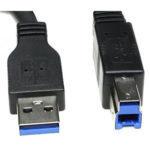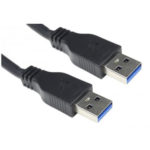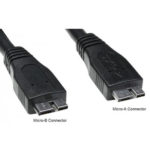Noticing a Difference with USB Cables
Have you noticed a difference in USB Cables?
The technological developments with USB 3.0 cables have challenged peripheral users on both sides of the coin. On one side, USB 3.0 cables have been engineered to transmit data at Super-Speed reaching up to 5Gbps while on the other, it is still compatible with its preceding technology USB 2.0 in certain respects.
 USB 2.0 cables were designed to handle High-Speed data bit interpretation when connected to external hard drives, USB hubs, or other devices that in some way transmit information to a host. The USB 2.0 specification essentially says that USB 2.0 cables and devices have the capability to interpret and receive information at a speed of up to 480Mbps, USB 3.0 technology has surpassed the previous standard 10 times over what High-Speed USB 2.0 is today.
USB 2.0 cables were designed to handle High-Speed data bit interpretation when connected to external hard drives, USB hubs, or other devices that in some way transmit information to a host. The USB 2.0 specification essentially says that USB 2.0 cables and devices have the capability to interpret and receive information at a speed of up to 480Mbps, USB 3.0 technology has surpassed the previous standard 10 times over what High-Speed USB 2.0 is today.
Here’s where the differences come in as the technology has changed. Because USB 3.0 speeds, design, and connectors have changed, so has the way in which it connects and interprets data streaming to your system. Look for the blue! In a simplified manner of an explanation, generally it still looks and feels like a USB 2.0 cable, with its black molded jackets and cabling, visually they are what you have come to know, but the connector color has changed from a polished metal jacket with a white molded internal contact support to blue (see image above) to distinguish between the two port and connector types, the USB 3.0 connector styles and number of internal contact pins have also changed.
Connecting USB 3.0 Type-A
As mentioned above, USB 3.0 cables have kept a certain compatibility with USB 2.0; the compatibility is with the support in speeds more than the cable connection itself. While supporting Super-Speed (5Gbps), USB 3.0 technology also supports High-Speed (480Mbps) and Full-Speed (12Mbps) from devices that also support lower speeds. The USB connector is different between the two in that the contacts inside of the USB 2.0 connector are round vs. USB 3.0 flat contact point with additional pins, this design change holds up better with frequent disconnecting.
connector is different between the two in that the contacts inside of the USB 2.0 connector are round vs. USB 3.0 flat contact point with additional pins, this design change holds up better with frequent disconnecting.
The Type-A connector provides a “downstream” connection that is for use only on host controllers (at the PC) and hubs. The USB 3.0 connector is similar in size and shape to the Type-A connector used in USB 2.0 / USB 1.1 applications. The USB 3.0 Type-A has additional pins that are not included in the USB 2.0 & USB 1.1 version of the connector.
The USB 3.0 cable and connectors are designed for Super-Speed applications (5Gbps); however, it will still carry data from slower speed connections from devices, and it is backwards compatible with USB 2.0 ports, the additional pin are not used. USB 3.0 cable connectors are blue in color to help identify them from previous versions.
Knowing Your USB 3.0 Connectors
We have mentioned that connector styles have changed, the design of USB ports on devices to support the new design changes has also changed, this makes some connectors such as a USB 3.0 Micro-B incompatible with other USB receptacles.
Connector Examples:
- Type-A USB 3.0 connector is used for “downstream” from host controllers and hubs.

- Type-B connector carries data and power for Super-Speed applications but is not backwards compatible with USB 2.0 or USB 1.1 devices. USB 3.0 devices with this connection type can accept previous USB 2.0 and 1.1 cabling.
- USB 3.0 Micro-B connectors are connectors designed for carrying data and power for Super-Speed applications, the connectors are of a wide but slim design with a keyway separating connection points.
- USB 3.0 Type-A & B connectors both male and female have been designed with a blue interior to distinguish itself from USB 2.0.
The differences between both USB 2.0 and USB 3.0 cabling technology has given us options for data speeds, some with a compatibility with USB 2.0 and some not. Be aware of what you are using for USB cabling, what version USB specification your system and devices supports, and whether or not you can use a cable designed for Super-Speed with your High-Speed applications.

